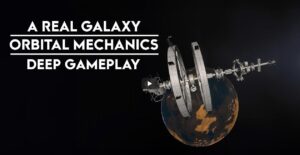Deephack (YouTube channel) has just started a short series of videos demonstrating the game 👨🚀
The first episode is demonstrating the cold start, departure, and reactor start-up procedures. In the second video Deephack is executing a transfer, approach and docking 👍

Coming from Deephack’s channel, I’m incredibly happy to see a new installment in the “sim-heavy space sim” genre. ASG looks amazing and I can’t wait to see and learn more. Thank you for doing this!
Hello Marvin, thanks for your encouraging words!
Just found this game project and I wanted to say that it looks really cool! It shows some great potential and I am looking forward to where it goes from here and I will probably get this the second that it becomes available for sale.
If you guys at any point need extra testers or something I would love be of help.
Thank you for your interest in the project!
About testing I’m afraid there won’t be new openings for a little while but if you want to volunteer the best is to subscribe to the newsletter. That’s the way I’m using to call for new testers actually!
Since life support systems could take up appreciable fractions of a ship’s mass, would there be fully automated NPC vessels in the sim? How would the player vessel interact would such vessels in a law enforcement context?
P.S. I just realized this is the exact same problem faced by contemporary traffic enforcement when it comes to the introduction of fully-autonomous ground vehicles.
That’s a good question! 🙂 At the moment all ship designs do feature crew quarters. Most of them are starliners carrying passengers who probably prefer to have flesh and blood pilots at the helm, but some utility vessels could certainly be fully automated indeed. However for security reasons it could be simply forbidden to have AI controlled torchships. Also with that game world supposed technology, the life support systems do not constitute such a large part of the dry mass actually. And that’s because of the reactor itself.
Another question for you: What is behind the decision to model radiators as solid “fins” rather than a liquid droplet design (e.g. curie point radiator), which seem to be quite an excellent choice for a warship as their fundamental design characteristics offers superior protection against weapons fire? (the particular subtype of LDR I exemplified is also predicted to be quite able to retain its working liquid despite relatively high accelerations)
I’d say simplicity, robustness and heat transfer capability. At a 50 GW fusion power and even with a radio-to-gamma highly reflective inner lining, the braking and cyclotron radiations are so strong that the thermal load on the vessel exceeds 2 GW. I considered that no active system (with pumps and the like) would be able to handle this and thus the reactor structure and radiators are supposed to be made of a carbon-carbon lattice of passive heat-pipes. These are also independent from one another, ensuring that damage remains localized.
In addition to this the ship can be very significantly maneuvering under thrust or between chained maneuvers (when the cooling need is highest) and even with a magnetic assistance a loss of droplets seems inevitable.
Finally law-enforcement warships in ASG are designed with one-on-one engagement in mind. In that configuration when pointing the spinal laser at an opponent, fins get naturally protected by presenting their edge (likely reinforced). On the contrary this is when droplet collectors would be the most exposed.